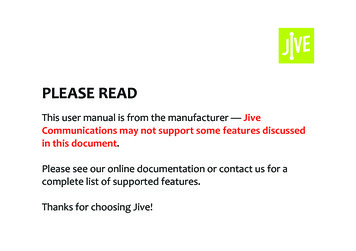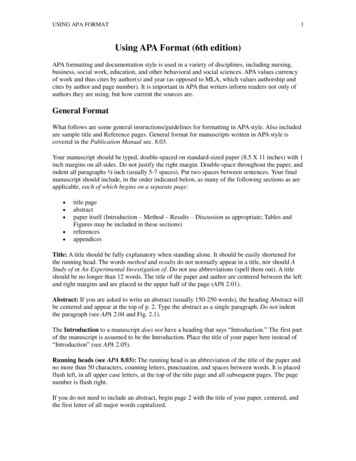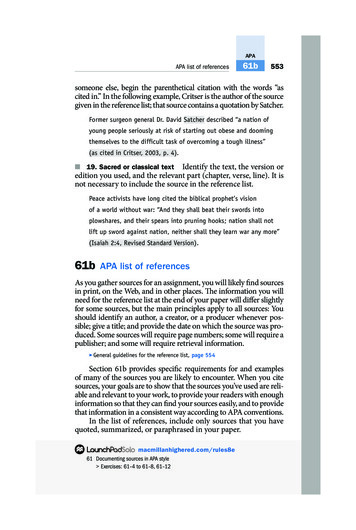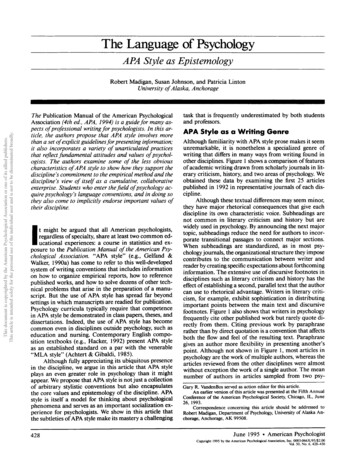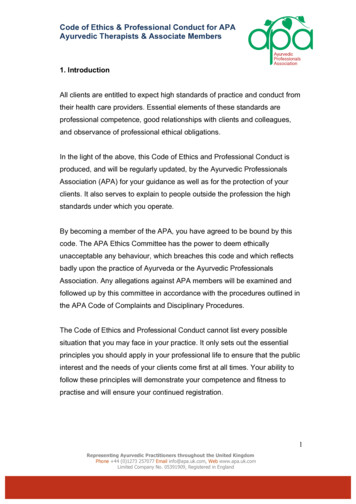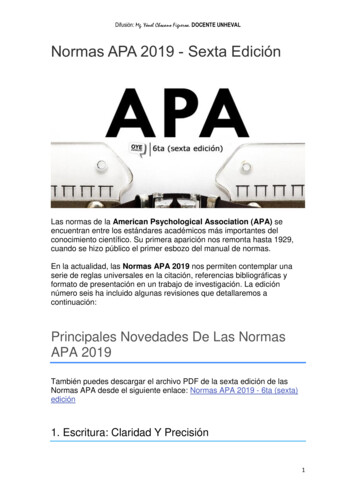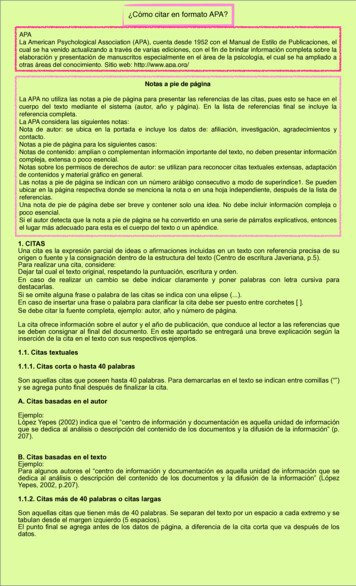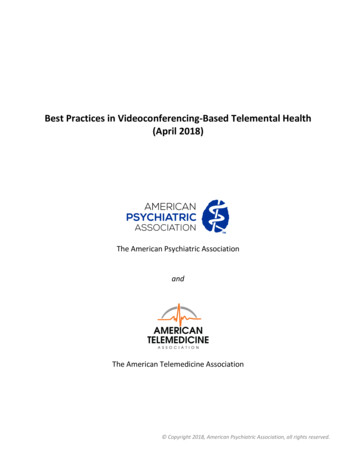
Transcription
Best Practices in Videoconferencing-Based Telemental Health(April 2018)The American Psychiatric AssociationandThe American Telemedicine Association Copyright 2018, American Psychiatric Association, all rights reserved.
WRITING COMMITTEE:Jay H. Shore, MD, MPH, Peter Yellowlees MD, MBBS, Robert Caudill, MD, Barbara Johnston, MSN,Carolyn Turvey, PhD, Matthew Mishkind, PhD, Elizabeth Krupinski, PhD, Kathleen Myers, MD, MPH,Peter Shore, PsyD, Edward Kaftarian, MD, Donald Hilty, MDSTAFF SUPPORT:Sabrina L. Smith (ATA), DrHA, Harry Mellon (ATA), Nathan Tatro, MA (APA), Michelle Dirst, MA (APA)REVIEWERS:Telemental Health Special Interest Group [ATA], APA Committee on Telepsychiatry (APA), ATA Standardsand Guidelines Committee Member [SG], ATA Staff [ATAS], APA Staff (APAS)1 Copyright 2018, American Psychiatric Association, all rights reserved.
Best Practices in Videoconferencing-Based Telemental HealthINTRODUCTIONThis document represents a collaboration between the American Psychiatric Association (APA)and the American Telemedicine Association (ATA) to create a consolidated update of theprevious APA and ATA official documents and resources in telemental health to provide a singleguide on best practices in clinical videoconferencing in mental health. The APA is the mainprofessional organization of psychiatrists and trainee psychiatrists in the United States, and thelargest psychiatric organization in the world. The ATA, with members from throughout theUnited States and the world, is the principal organization bringing together telemedicinepractitioners, healthcare institutions, government agencies, vendors and others involved inproviding remote healthcare using telecommunications.Telemental health in the form of interactive videoconferencing has become a critical tool in thedelivery of mental health care. It has demonstrated its ability to increase access and quality ofcare, and in some settings to do so more effectively than treatment delivered in-person.The APA and the ATA have recognized the importance of telemental health with each individualassociation undertaking efforts to educate and provide guidance to their members in thedevelopment, implementation, administration and provision of telemental health services. It isrecommended that this guide be read in conjunction with the other APA and ATA resources thatprovide more detail.OFFICIAL APA AND ATA GUIDELINES, RESOURCES AND TELEMENTAL HEALTHTRAININGSAPAATA1) APA Web-based Telepsychiatry Toolkit(2016)2) Resource Document on Telepsychiatry andRelated Technologies in Clinical Psychiatry,Council on Law and Psychiatry (2014)3) American Psychiatric Association.Telepsychiatry via Videoconferencing.(1998)4) Practice Guidelines for Telemental Healthwith Children and Adolescents (2017)5) Telemental Health Resource Toolbox(2017)6) Online Training for Video-Based OnlineMental Health Service (2014)7) A Lexicon of Assessment and OutcomeMeasures for Telemental health (2013)8) Practice Guidelines for Video-Based OnlineMental Health Service (2013)9) Practice Guidelines for VideoconferencingBased Telemental Health (2009)10) Evidence-Based Practice for TelementalHealth (2009)These guidelines focus on interactive videoconferencing-based mental health services (a.k.a.,telemental health). The use of other technologies such as virtual reality, electronic mail,electronic health records, telephony, remote monitoring devices, chat rooms, or social networks1 Copyright 2018, American Psychiatric Association, all rights reserved.
Best Practices in Videoconferencing-Based Telemental Healthare not a focus of this document except where these technologies interface withvideoconferencing services.The document was created by a joint writing committee drawn from the APA Committee onTelepsychiatry and the ATA Telemental Health Special Interest Group (TMH SIG). This documentdraws directly from ATA’s three previous guidelines, selecting from key statements/guidelines,consolidating them across documents and then updating them where indicated. Followinginternal review processes within the APA and the ATA, the Board of Directors of the ATA and theJoint Reference Committee (JRC) of the APA, have given approval to its publication.The reference list includes several detailed reviews providing justification and documentation ofthe scientific evidence supporting telemental health. Following ATA guideline writingconvention, this document contains requirements, recommendations, or actions that areidentified by text containing the keywords “shall,” “should,” or “may.” “Shall” indicates that itis required whenever feasible and practical under local conditions. “Should” indicates anoptimal recommended action that is particularly suitable, without mentioning or excludingothers. “May” indicates additional points that may be considered to further optimize thetelemental health care process.It should be recognized that compliance with these recommendations will not guaranteeaccurate diagnoses or successful outcomes. The purpose of this guide is to assist providers inproviding effective and safe medical care founded on expert consensus, research evidence,available resources, and patient needs.This document is not meant to establish a legal standard of care.ADMINISTRATIVE CONSIDERATIONSA. PROGRAM DEVELOPMENTProviders or organizations delivering mental health services should conduct a telehealth needsassessment prior to initiating services. This needs assessment should include, at a minimum, thefollowing components: program overview statement, services to be delivered, proposed patientpopulation, provider resources, technology needs, staffing needs, quality and safety protocols,business and regulatory processes, space requirements, training needs, evaluation plan, andsustainability.B. LEGAL AND REGULATORY ISSUES1) Licensure and MalpracticeHealth care services have been defined as delivered in the state where the patient is located.Providers of telemental health services shall comply with state licensure laws, which typicallyentail holding an active professional license issued by the state in which the patient is physicallylocated during a telemental health session, and shall have appropriate malpractice coverage.Providers shall conduct their own due diligence to determine the type of licensure required, andensure they are in compliance with state licensing board regulations. If providing care within afederal healthcare system (e.g., Department of Veterans Affairs, Department of Defense, IndianHealth Service), providers shall follow the specific organization guidelines around licensure,which may allow for a single state licensure across multiple jurisdictions. Providers may utilize2 Copyright 2018, American Psychiatric Association, all rights reserved.
Best Practices in Videoconferencing-Based Telemental Healththe interstate licensure compact or special telemedicine licensures offered by certain statesprovided they comply with all individual state licensure and program requirements.2) Scope of PracticeProviders or organizations offering telemental health services shall ensure that the standard ofcare delivered via telemedicine is equivalent to in-person care. Persons engaged in telementalhealth services shall be aware of their professional organization’s positions on telemental healthand incorporate the professional association standards and clinical practice guidelines wheneverpossible. Providers in practice and trainees should stay current with evolving technologies,telemental health research findings, and policies.3) PrescribingProviders shall be aware of both federal and state guidelines around the prescription ofcontrolled substances, including the Ryan Haight Online Pharmacy Consumer Protection Act of2008. Providers shall comply with federal and state regulations around the prescription ofcontrolled substances based on the setting, model of care, scope of practice and locations inwhich they are practicing and where the patient is located at the time of treatment.4) Informed ConsentLocal, state, and national laws regarding verbal or written consent shall be followed. If writtenconsent is required, then electronic signatures, assuming these are allowed in the relevantjurisdiction, may be used. The provider shall document the provision of consent in the medicalrecord.5) Billing and ReimbursementThe patient shall be made aware of any and all financial charges that may arise from the servicesto be provided prior to the commencement of initial services. Appropriate documentation andcoding should be undertaken specifying when services are rendered via telemental health.C. STANDARD OPERATING PROCEDURES/PROTOCOLSPrior to initiating telemental health services, any organization or provider shall have in place aset of Standard Operating Procedures or Protocols that should include (but are not limited to)the following administrative, clinical, and technical specifications:3 Roles, responsibilities (i.e., daytime and after-hours coverage), communication, andprocedures around emergency issues. Agreements to assure licensing, credentialing, training, and authentication ofpractitioners as well as identity authentication of patients according to local, state, andnational requirements. A systematic quality improvement and performance management process that complieswith any organizational, regulatory, or accrediting, requirements for outcomesmanagement. Copyright 2018, American Psychiatric Association, all rights reserved.
Best Practices in Videoconferencing-Based Telemental Health1) Patient-Provider IdentificationAll persons at both sites of the videoconference shall be identified to all participants at thebeginning of a telemental health session. Permission from the patient should not be required ifsafety concerns mandate the presence of another individual or if the patient is being legallydetained.At the beginning of a video-based mental health treatment with a patient, the followinginformation shall be verified and documented: The name and credentials of the provider and the name of the patient. The location(s) of the patient during the session. Immediate contact information for both provider and patient (phone, text message, oremail), and contact information for other relevant support people, both professional andfamily. Expectations about contact between sessions shall be discussed and verified with thepatient, including a discussion of emergency management between sessions.2) Emergenciesi. General ConsiderationsProfessionals shall maintain both technical and clinical competence in the management ofmental health emergencies. Provisions for management of mental health emergencies shall beincluded in any telemental health procedure or protocol. Clinicians shall be familiar with localcivil commitment regulations and should have arrangements to work with local staff toinitiate/assist with civil commitments or other emergencies.ii. Clinically supervised settingsClinically supervised settings are patient locations where other medical or support staff areavailable in real-time to support the telemental health sessions. Emergency protocols shall becreated with clear explanation of roles and responsibilities in emergency situations. Theseinclude determination of outside clinic hours emergency coverage and guidelines fordetermining when other staff and resources should be brought in to help manage emergencysituations. Clinicians shall be aware of safety issues with patients displaying strong affective orbehavioral states upon conclusion of a session and how patients may then interact with remotesite staff.iii. Clinically unsupervised settingsIn instances where the mental health provider is providing services to patients in settingswithout clinical staff immediately available: 4Providers should discuss the importance of having consistency in where the patient islocated for sessions and knowing a patient’s location at the time of care, as it impactsemergency management and local available resources. Copyright 2018, American Psychiatric Association, all rights reserved.
Best Practices in Videoconferencing-Based Telemental Health As patients change locations, providers shall be aware of the impact of location onemergency management protocols. These include emergency regulations, resources(e.g., police, emergency rooms, crisis teams), and contacts. These should bedocumented and available to providers. For treatment occurring in a setting where the patient is seen without access to clinicalstaff, the provider should consider the use of a “Patient Support Person” (PSP) asclinically indicated. A PSP is a family, friend or community member selected by thepatient who could be called upon for support in the case of an emergency. The providermay contact the Patient Support Person to request assistance in evaluating the nature ofemergency and/or initiating 9-1-1 from the patient’s home. If a patient and/or a PSP will not cooperate in his or her own emergency management,providers shall be prepared to work with local emergency personnel in case the patientneeds emergency services and/or involuntary hospitalization.3) Care CoordinationWith consent from the patient and in accordance with privacy guidelines, telemental healthproviders should arrange for appropriate and regular communication with other professionals andorganizations involved in the care of the patient.TECHNICAL CONSIDERATIONSA. VIDEOCONFERENCING PLATFORM REQUIREMENTSProviders and organizations should select video conferencing applications that have theappropriate verification, confidentiality, and security parameters necessary to be properlyutilized for this purpose. In the event of a technology breakdown, causing a disruption of thesession, the professional shall have a backup plan in place (e.g., telephone access). Telementalhealth shall provide services at a bandwidth and with sufficient resolutions to ensure the qualityof the image and/or audio received is appropriate to the services being delivered.B. INTEGRATION OF VIDEOCONFERENCING INTO OTHER TECHNOLOGY AND SYSTEMSOrganizations shall ensure the technical readiness of the telehealth equipment and the clinicalenvironment. They shall have policies and procedures in place to ensure the physical security oftelehealth equipment and the electronic security of data. Organizations shall ensure compliancewith all relevant safety laws, regulations, and codes for technology and technical safety.Privacy, Security, HIPAAFor telemental health services provided within the United States, the United States HealthInsurance Portability & Accountability Act (HIPAA) of 1996, and state privacy requirements, shallbe followed at all times to protect patient privacy. Privacy requirements in other countries shallbe followed for telemental health services provided in those countries.Patients receiving mental health and substance use disorder services are afforded a higherdegree of patients’ rights as well as organizational responsibilities (e.g., need for specific consentfrom patients to release information around substance use). Telemental health organizations5 Copyright 2018, American Psychiatric Association, all rights reserved.
Best Practices in Videoconferencing-Based Telemental Healthshall be aware of these additional responsibilities and ensure that they are achieved. Telementalhealth organizations and providers shall determine processes for documentation, storage, andretrieval of telemental health records.C. PHYSICAL LOCATION/ROOM REQUIREMENTSDuring a telemental health session, both locations shall be considered a patient examinationroom regardless of a room’s intended use. Providers shall ensure privacy so clinical discussioncannot be overheard by others outside of the room where the service is provided. To the extentpossible, the patient and provider cameras should be placed at the same elevation as the eyeswith the face clearly visible to the other person. The features of the physical environment forboth shall be adjusted so the physical space, to the degree possible, maximizes lighting, comfortand ambiance.When asynchronous telemental health consultations are occurring, the interviewer should beappropriately trained, and the digital recording of the interview shall be shared and stored inaccordance with HIPAA regulations.CLINICAL CONSIDERATIONSA. PATIENT AND SETTING SELECTIONThere are no absolute contraindications to patients being assessed or treated using telementalhealth. The use of telemental health with any individual patient is at the discretion of theprovider. For clinically unsupervised settings (e.g., home, office) where support staff is notimmediately available, providers shall consider appropriateness of fit for an individual patient.Provision of telemental health services in professionally unsupervised settings requires that thepatient take a more active and cooperative role in the treatment process than would be thecase for in-person locales. Patients need to be able to set up the videoconferencing system,maintain the appropriate computer/device settings, establish a private space, and cooperate foreffective safety management. Factors to consider include:6 Providers should consider such things as patient’s cognitive capacity, history regardingcooperativeness with treatment professionals, current and past difficulties withsubstance abuse, and history of violence or self-injurious behavior. Providers shall consider geographic distance to the nearest emergency medical facility,efficacy of patient’s support system, and current medical status. The consent process shall include discussion of circumstances around sessionmanagement so that if a patient can no longer be safely managed through distancetechnology, the patient is aware that services may be discontinued. Providers should consider whether there are any medical aspects of care that wouldrequire in-person examination including physical exams. If the provider cannot managethe medical aspects for the patient without being able to conduct initial or recurrentphysical exams, this shall be documented in the record, and arrangements shall be madeto perform physical exams onsite as clinically indicated. Copyright 2018, American Psychiatric Association, all rights reserved.
Best Practices in Videoconferencing-Based Telemental HealthB. MANAGEMENT OF HYBRID PATIENT-PROVIDER RELATIONSHIPSTelemental health interviews can be conducted as part of a wider, in-person and online clinicalrelationship using multiple technologies by providers working individually or in teams. Thetelemental health interview can be an adjunct to periodic face-to-face in person contact or canbe the only contact. It is typically supported by additional communications technologies such asfaxed or emailed consultation information, patient portals, telephone, mobile devices, andelectronic health records. Providers should have clear policies pertaining to communicationswith patients. These should describe the boundaries around ways in which patients cancommunicate with a provider, which content is appropriate to share over different technologyplatforms, anticipated response times, and how and when to contact a provider. Providersshould identify clearly which platforms are acceptable for communication of an emergency andexpected response times. Providers should be attentive of the impact of different technologyplatforms on patient rapport and communication. All modes of communication of personalhealth history shall be HIPAA compliant.C. ETHICAL CONSIDERATIONSHealth professionals shall be responsible for maintaining the same level of professional andethical discipline and clinical practice principles and guidelines as in person care in the delivery ofcare in telemental health, as well as additional telemental health related concerns such asconsent processes, patient autonomy, and privacy.D. CULTURAL ISSUESTelemental health providers should be culturally competent to deliver services to thepopulations that they serve. Providers should familiarize themselves with the cultures andenvironment where they are working and may use site visits and cultural facilitators to enhancetheir local knowledge when appropriate and practical. Providers should assess a patient’sprevious exposure, experience, and comfort with technology/video conferencing. They shall beaware of how this might impact initial telemental health interactions. Providers should conductongoing assessment of the patient’s level of comfort with technology over the course oftreatment.E. SPECIFIC POPULATIONS AND SETTINGS1) Child/Adolescent PopulationsTelemental health procedures for the evaluation and treatment of youth shall follow the sameguidelines presented for adults with modifications to consider the developmental status ofyouth such as motor functioning, speech and language capabilities, relatedness, and relevantregulatory issues. When working with younger children the environment should facilitate theassessment by providing an adequate room size, furniture arrangement, toys, and activitiesthat allow the youth to engage with the accompanying parent, presenter, and provider anddemonstrate age-appropriate skills.Extended participation of family members or other relevant adults is typical of mental healthtreatment of children and adolescents. Providers should adhere to usual in-person practicesfor including relevant adults with appropriate modifications for delivering service throughvideoconferencing in the context of resources at the patient site. Extended participation mayinclude a “presenter” w h o may facilitate sessions (e.g., vital signs, assistance with rating7 Copyright 2018, American Psychiatric Association, all rights reserved.
Best Practices in Videoconferencing-Based Telemental Healthscales, managing active children, assisting with any urgent interventions) Providers shouldconsider how the presenter’s involvement can affect service delivery (e.g., social familiaritywith the family, perceived confidentiality, sharing information with other team members).When telemental services are delivered outside of traditional clinic settings (e.g., schools)providers should work with staff to ensure safety, privacy, appropriate setting, andaccommodations. This is particularly true if multiple staff participate in sessions.Appropriateness for telemental care shall consider safety of the youth, the availability ofsupportive adults, the mental health status of those adults, and ability of the site to respondto any urgent or emergent situations.2) Forensic and CorrectionalProviders shall be aware of systems issues in working in forensic and correctional settings andfollow applicable standard consent around both treatment and evaluation in terms of patient’slegal status and rights. Provider shall have clear site-specific protocols about working withpatients and staff in forensic and correctional settings.3) GeriatricThe geriatric patient often has multiple medical problems and the inclusion of family membersshould be undertaken as clinically appropriate and with the permission of the patient.Interviewing techniques shall be adapted for patients who may be cognitively impaired, find itdifficult to adapt to the technology, or have visual or auditory impairment. Cognitive testing maybe provided via videoconferencing but might need to be modified for use via video.Organizations administrating cognitive testing via videoconferencing shall be aware of theproperties of the individual test instrument, how it may be impacted by videoconferencing, andany potentially needed modifications.4) Military, Veteran and other federal populationsProviders shall be familiar with the federal and specific organizational structures and guidelinesfor patients related to the location of care. Providers should familiarize themselves with theculture of the patients (e.g., military cultural competency) and the organizational systems inwhich they practice.5) Substance Use Disorder TreatmentProviders shall be aware of and comply with federal, state and local regulations aroundprescription of controlled substances involved in Substance Use Disorder treatment. Providersshall coordinate with onsite staff to provide appropriate standard of care including carecoordination and monitoring of physiological parameters for monitoring of ongoing treatmentas clinically indicated.6) Inpatient and Residential SettingsProviders should work to integrate themselves into inpatient and residential care settings wherethey practice through virtual participation in administration and organizational meetingsincluding clinical case staffing on a routine/regular basis. Remote providers should optimize useof patient site staff for help with telemental health consultations and case coordination asclinically indicated. Inpatient units should provide the telemental health provider with adequate8 Copyright 2018, American Psychiatric Association, all rights reserved.
Best Practices in Videoconferencing-Based Telemental Healthaccess to patients, members of the interdisciplinary treatment team, and primary medicalproviders and nursing support when appropriate.7) Primary Care SettingsProviders should be aware of best practice in leveraging telepsychiatry to support integratedcare across a continuum of models including direct patient assessment, consultative models,(e.g., asynchronous) and team-based models of care. Providers practicing integrated caretelepsychiatry should attend to the impact of virtual interactions on team processes, dynamics,and patient outcomes in the delivery of integrated care.8) RuralProviders should be familiar with the impact of rural environments on treatment includingfirearm ownership, kinship in small communities, local geographic barriers to care and generalavailability of healthcare resources.KEY REFERENCESFoundational Documents1. APA Web-based Telemental health Toolkit ctice/telemental health2. Recupero, P., & Fisher, J. C. E. (2014). Resource Document on Telemental health andRelated Technologies in Clinical Psychiatry.3. American Psychiatric Association. Telemental health via Videoconferencing. (1998)4. Myers, K., Nelson, E. L., Rabinowitz, T., Hilty, D., Baker, D., Barnwell, S. S.,. & Comer, J.S. (2017). American Telemedicine Association Practice Guidelines for TelementalHealth with Children and Adolescents. Telemedicine and e-Health.5. Turvey C, Yellowlees P, Shore JH, Shore P. Delivering Online Video Based MentalHealth Services. American Telemedicine Association Learning Center, og/item/id/241193;jsessionid 811FB256406248FFC1A45D3835DF3A99.worker1)6. Turvey C, Coleman M, Dennison O, Drude K, Goldenson M, Hirsch P, Jueneman R,Kramer GM, Luxton DD, Maheu MM, Malik TS, Mishkind MC, Rabinowitz T, Roberts LJ,Sheeran T, Shore JH, Shore P, van Heeswyk F, Wregglesworth B, Yellowlees P, ZuckerML, Krupinski EA, Bernard J.(2013). ATA practice guidelines for video-based onlinemental health services. Telemedicine Journal and E Health, 19(9),722-30. doi:10.1089/tmj.2013.99897. American Telemedicine Association. (2013). Practice guidelines for video-based onlinemental health services. Washington, DC, USA.8. Yellowlees, P., Shore, J., & Roberts, L. (2010). Practice guidelines forvideoconferencing-based telemental health–October 2009. Telemedicine and eHealth, 16(10), 1074-1089.9. Grady, B., Myers, K. M., Nelson, E. L., Belz, N., Bennett, L., Carnahan, L., . & Rowe, N.(2011). Evidence-based practice for telemental health. Telemedicine and e-Health,17(2), 131-148.Key Reviews and Updates10. Hubley, S., Lynch, S. B., Schneck, C., Thomas, M., & Shore, J. (2016). Review of key9 Copyright 2018, American Psychiatric Association, all rights reserved.
Best Practices in Videoconferencing-Based Telemental Healthtelemental health outcomes. World journal of psychiatry, 6(2), 269.11. Bashshur, R. L., Shannon, G. W., Bashshur, N., & Yellowlees, P. M. (2016). Theempirical evidence for telemedicine interventions in mental disorders. Telemedicineand e-Health, 22(2), 87-113.12. Hilty, D. M., Ferrer, D. C., Parish, M. B., Johnston, B., Callahan, E. J., & Yellowlees, P. M.(2013). The effectiveness of telemental health. Telemedicine and e-Health, 19(6), 44445413. Shore, J. H. (2013). Telemental health: videoconferencing in the delivery of psychiatriccare. American Journal of Psychiatry, 170(3), 256-262.10 Copyright 2018, American Psychiatric Association, all rights reserved.
6) Online Training for Video-Based Online Mental Health Service (2014) 7) A Lexicon of Assessment and Outcome Measures for Telemental health (2013) 8) Practice Guidelines for Video-Based Online Mental Health Service (2013) 9) Practice Guidelines for Videoconferencing-Based Telemental Health (2009) 10) Evidence-Based Practice for Telemental
